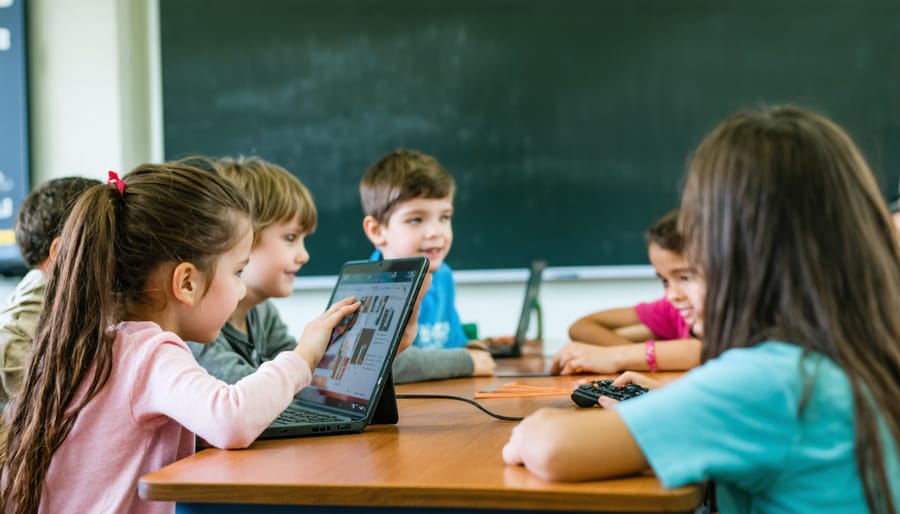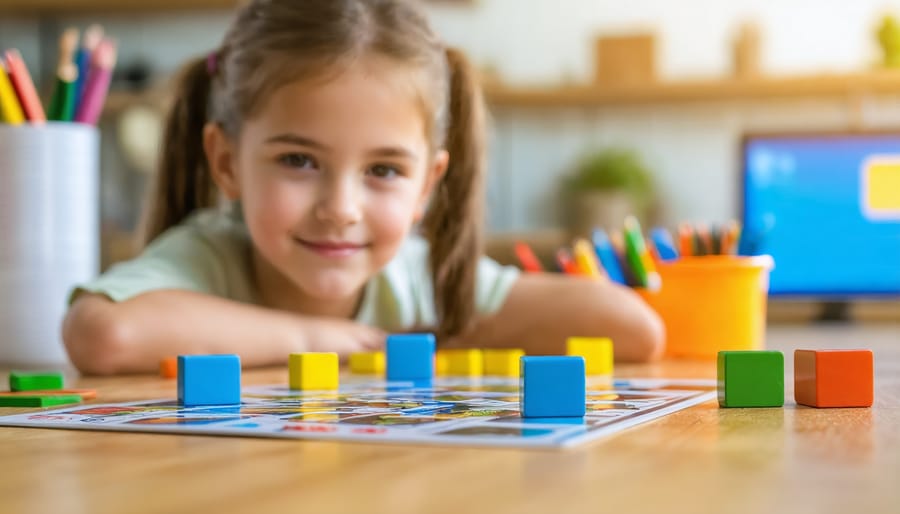Your Students Will Actually Beg to Review When You Use These Game Design Secrets
**Design games with clear learning objectives first, then build mechanics around them.** Start by identifying exactly what students need to learn—whether it’s multiplication facts, historical events, or vocabulary—then choose game elements that naturally reinforce those concepts. A matching game works beautifully for vocabulary, while a race-style game suits math fluency practice.
**Layer challenge progressively to keep all students engaged.** Begin with easier levels that build confidence, then gradually increase difficulty as players demonstrate mastery. This scaffolding prevents frustration for struggling learners while keeping advanced students motivated. Include multiple pathways to success so different learning styles can shine.
**Make feedback immediate and specific.** Students learn best when they know right away whether their answer is correct and why. Use visual cues, sound effects, or brief explanations that celebrate success and gently guide learners toward the right answer without discouragement.
**Prioritize customization to fit your classroom’s unique needs.** The most effective educational games adapt to different skill levels, learning objectives, and time constraints. When you can swap out questions, adjust difficulty, or modify rules, one game template becomes dozens of targeted learning experiences throughout the year.
What Makes an Educational Game Actually Educational?
Not all games are created equal when it comes to learning! You’ve probably seen students have a blast playing games that look educational but don’t actually reinforce the content you’re teaching. So what’s the secret sauce that makes game-based learning truly effective?
The magic happens when fun and learning work together, not against each other. An educational game should make students think about your content to succeed, not just rely on luck or quick reflexes. Think of it this way: if students could play your game without knowing anything about the topic and still win, it’s entertainment, not education.
The best educational games put learning at the heart of gameplay. Every decision students make should connect to your lesson objectives. When they answer a question correctly, solve a problem, or apply a concept, they should advance in the game. The fun becomes the reward for learning, not a distraction from it.
Here’s your checkpoint: Can students play without actually thinking about your content? If yes, it’s time to redesign. The game mechanics should require students to engage with the material meaningfully.
Balance is key! You want enough challenge to keep things interesting but not so much difficulty that students get frustrated. Games should feel exciting and motivating while reinforcing what you’ve taught. When done right, students won’t even realize how much they’re learning because they’re having such a great time.
Remember, the goal isn’t just engagement—it’s engaged learning that sticks with your students long after the game ends.

The Three Core Elements Every Classroom Game Needs

Clear Learning Targets Built Right In
The secret to great educational games? Every single move students make should teach them something. Think of it like this: if your game mechanic is matching cards, those cards should feature vocabulary words, math equations, or science concepts—not random images.
Start by asking yourself, “What do I want my students to walk away knowing?” Then build your game around that answer. If you’re teaching multiplication facts, design a racing game where correct answers fuel the car forward. Teaching geography? Create a treasure hunt where students identify locations to unlock clues.
The beauty of this approach is that students practice without even realizing it. They’re so focused on winning the game that the learning sneaks in naturally. Each question, each challenge, each puzzle piece should directly connect to your lesson objective.
Here’s your game-changer tip: write your learning target at the top of your planning page before designing anything else. This keeps you focused and prevents the game from becoming “just for fun” without educational punch. When mechanics and objectives align perfectly, students learn more with every round they play—and they’ll actually ask to play again!
Competition That Includes Everyone
The real magic happens when every student feels they have a shot at winning! Traditional scoring can accidentally sideline struggling learners, but smart game design keeps everyone in the race.
Try leveling the playing field with differentiated point systems. Award bonus points for improvement, effort, or creative thinking—not just correct answers. You might give extra credit for helping teammates or attempting challenging questions. This way, students contribute in multiple ways beyond pure academic performance.
Consider using team-based review games where you intentionally mix ability levels. Assign roles like “researcher,” “presenter,” or “encourager” so everyone has a specific job. When teams succeed together, quieter students gain confidence and high achievers develop leadership skills.
Another winning approach? Progressive challenges where difficulty increases throughout the game. Early rounds let everyone rack up points and feel successful, while later rounds offer bigger rewards for tougher questions.
You can also introduce “comeback mechanics”—special opportunities for teams that fall behind to earn multipliers or bonus rounds. This prevents students from mentally checking out halfway through.
Remember, customization is your superpower! Adjust rules on the fly based on how your class responds. The goal isn’t finding one perfect system—it’s creating an environment where every student believes their participation matters.
Instant Feedback That Teaches
The magic happens when your students learn *during* the game, not just at the end. Instead of simply awarding points for correct answers, design games that guide learners through their mistakes with immediate, helpful feedback.
Think of it like this: when a student selects the wrong answer, don’t just mark it incorrect. Show them *why* it’s wrong and gently point them toward the right thinking. For example, if they’re practicing multiplication and choose 24 as the answer to 6×5, your game could respond with: “Close! You’ve got 6×4. Try adding one more group of 6.”
This approach transforms mistakes into stepping stones rather than roadblocks. Students feel supported instead of discouraged, and they’re much more likely to try again.
Here’s the best part: you can customize feedback to match your students’ needs. For struggling learners, provide more detailed hints. For advanced students, offer subtle nudges that encourage problem-solving.
The key is keeping feedback positive and specific. Replace generic “Try again!” messages with responses that actually teach. When students understand their errors in real-time, they build confidence and genuine understanding—making your game a true learning tool, not just a quiz in disguise.
Game Design Techniques That Work in Any Subject
The Power of Customization
Here’s the secret that transforms a good game into a great learning experience: customization! When you take popular game templates and tailor them to your specific content and students, the engagement level skyrockets.
Think about it—your fifth graders learning fractions have completely different needs than high schoolers studying Shakespeare. The beauty of customizable game templates is that you can plug in exactly what your students need to practice, whether that’s vocabulary words, math problems, or historical dates.
The best part? Customization doesn’t require technical wizardry! Start simple by replacing generic questions with your own content. Add student names to scenarios to boost engagement. Include inside jokes or references to recent class discussions—students love spotting these personal touches!
Try these quick wins: adjust difficulty levels to match your learners, incorporate current units you’re teaching, and use images or examples relevant to your students’ interests. A basketball-themed math game works wonders with sports enthusiasts, while pop culture references resonate with middle schoolers.
Remember, even five minutes of customization makes your game feel specially designed for your classroom. Students notice when you’ve made that effort, and their enthusiasm—and learning—reflects it!
Sound Effects and Visual Cues That Amplify Engagement
Think about the last time you heard a satisfying “ding!” when completing a task on your phone. That little sound made you feel accomplished, right? The same principle works wonders in educational games, and you can harness this power in your classroom!
Sound effects, timers, and scoreboards aren’t just decorative features—they’re powerful psychological tools that keep students engaged and motivated. When a student answers correctly and hears a cheerful chime, their brain releases dopamine, creating a positive association with learning. Visual cues like progress bars show students exactly how far they’ve come, reducing anxiety and boosting confidence.
Timers add just the right amount of pressure to maintain focus without causing stress. They create urgency that transforms routine practice into an exciting challenge. Meanwhile, scoreboards tap into students’ natural desire for achievement and friendly competition, encouraging them to push themselves further.
The beauty of these features is their flexibility. You can customize sound effects to match your classroom vibe—gentle tones for younger learners or energetic sounds for older students. Adjust timer speeds based on skill levels, and choose whether to display scores publicly or keep them private. These seemingly simple elements work together to create an immersive learning experience that keeps students coming back for more.
Pacing and Time Management in Game-Based Learning
Timing is everything! The best educational game falls flat if students barely get started before the bell rings. When designing or selecting games, always work backward from your class period. If you have 45 minutes, aim for 25-30 minutes of active gameplay, leaving crucial time for setup and, most importantly, debriefing.
Keep momentum strong by building in natural checkpoints rather than one long marathon session. Quick rounds work better than extended play—students stay engaged when they can see progress and celebrate small wins along the way.
Don’t skip the reflection time! Those final 10-15 minutes are where the magic happens. This is when students connect game experiences to real learning objectives. Ask questions like “What strategies worked?” or “How does this relate to what we’re studying?” Without debriefing, you’ve got entertainment, not education.
Pro tip: Test-run your game beforehand to catch timing issues. You can always customize rules to speed things up or add complexity for longer periods!
Team Building Through Game Mechanics
Games become powerful community builders when you design them with teamwork at their core! Start by creating mixed-ability pairs strategically—match students who complement each other’s strengths rather than grouping by skill level alone. This builds confidence and peer support naturally.
Incorporate collaborative elements where success depends on everyone contributing. Think relay-style questions where each team member answers different parts, or puzzle games where students must share information to solve problems together. The key is making cooperation essential, not optional.
Try rotating partnerships throughout the game to help students work with different classmates. This breaks down social barriers while keeping energy high. You can also add bonus points for teams that demonstrate excellent communication or help struggling partners.
Remember to customize roles within teams—maybe one student reads, another writes, and someone else presents. This ensures every voice matters and creates natural accountability while reviewing your content in an engaging, memorable way!

Avoiding the Biggest Educational Game Design Mistakes
Even the most well-intentioned educational games can miss the mark if they fall into these common traps. Let’s make sure your game hits all the right notes!
**Mistake #1: Making it too educational.** Yes, you read that right! When games feel like worksheets in disguise, students see right through it. The learning should flow naturally through gameplay, not feel tacked on. Think about making the educational content the key to winning, not an interruption to the fun.
**Mistake #2: Forgetting about your audience.** A game that works brilliantly for third graders might bore high schoolers to tears. Always design with your specific students in mind. What motivates them? What challenges them without frustrating them? Customization is your friend here—adjust difficulty levels and content to match where your students are right now.
**Mistake #3: Overcomplicating the rules.** If you spend 15 minutes explaining how to play, you’ve already lost half your class. Keep mechanics simple and intuitive. Students should grasp the basics in under two minutes and learn deeper strategies through playing.
**Mistake #4: Skipping the feedback loop.** Students need to know immediately if they’re on the right track. Design your game so success and mistakes are clear and provide instant feedback. This keeps engagement high and helps learning stick.
**Mistake #5: No clear learning outcome.** Before designing anything, ask yourself: “What exactly should students know or be able to do after playing?” Without this clarity, your game becomes just entertainment without purpose.
Remember, the best educational games make students forget they’re learning while they’re having a blast!
From Download to Classroom: Making Game Implementation Easy
You’ve found the perfect game template—now let’s get it into your classroom with minimal stress! The key is starting small and building confidence.
**Quick Prep Strategies**
First, give yourself 15 minutes to play through the game solo. This helps you anticipate questions and spot any customization opportunities. Download and customize the template the night before, adjusting content to match your current unit. Print any necessary materials and have a backup plan ready (tech hiccups happen to everyone!).
**Introducing Games to Students**
Start with a 2-minute demo. Show students exactly what they’ll be doing rather than explaining every rule. Let them know this is about learning while having fun—not about winning at all costs. Set clear expectations: respectful competition, teamwork, and celebrating everyone’s efforts.
**Maximizing Impact**
Keep your first game session short—around 10-15 minutes. This builds excitement and leaves them wanting more. After playing, spend 3-5 minutes debriefing. Ask what they learned and what strategies worked best. This reflection reinforces the educational content while making review sessions engaging.
**Time-Saving Tip**
Once you’ve successfully used a game template, save your customized version in a “Ready to Go” folder. You’ll thank yourself later when you need a quick activity! With practice, implementation becomes second nature, turning game time into your students’ favorite learning moments.
Ready to give educational games a try? Here’s the good news: you don’t need to transform your entire teaching approach overnight. Start small—pick just one game technique from today’s discussion and test it during your next review session. Maybe it’s a simple point system, a quick team challenge, or turning flashcards into a competitive activity. The beauty of educational games is that they don’t require hours of elaborate prep work. Often, the most effective games are the simplest ones that get students actively participating and having fun while learning.
Your students are waiting for that spark of excitement in the classroom. Why not make review time the moment they look forward to most? Transform those traditionally dull study sessions into energizing experiences where learning feels like play. You’ve got this—now go create some memorable learning moments!


